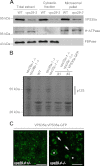Mechanisms governing the endosomal membrane recruitment of the core retromer in Arabidopsis
- PMID: 23362252
- PMCID: PMC3610957
- DOI: 10.1074/jbc.M112.440503
Mechanisms governing the endosomal membrane recruitment of the core retromer in Arabidopsis
Abstract
The retromer complex localizes to endosomal membranes and is involved in protein trafficking. In mammals, it is composed of a dimer of sorting nexins and of the core retromer consisting of vacuolar protein sorting (VPS)26, VPS29, and VPS35. Although homologs of these proteins have been identified in plants, how the plant retromer functions remains elusive. To better understand the role of VPS components in the assembly and function of the core retromer, we characterize here Arabidopsis vps26-null mutants. We show that impaired VPS26 function has a dramatic effect on VPS35 levels and causes severe phenotypic defects similar to those observed in vps29-null mutants. This implies that functions of plant VPS26, VPS29, and VPS35 are tightly linked. Then, by combining live-cell imaging with immunochemical and genetic approaches, we report that VPS35 alone is able to bind to endosomal membranes and plays an essential role in VPS26 and VPS29 membrane recruitment. We also show that the Arabidopsis Rab7 homolog RABG3f participates in the recruitment of the core retromer to the endosomal membrane by interacting with VPS35. Altogether our data provide original information on the molecular interactions that mediate assembly of the core retromer in plants.
Figures








Similar articles
-
Retromer association with membranes: plants have their own rules!Plant Signal Behav. 2013 Sep;8(9):e25312. doi: 10.4161/psb.25312. Epub 2013 Jun 27. Plant Signal Behav. 2013. PMID: 23803747 Free PMC article.
-
Molecular insights into Rab7-mediated endosomal recruitment of core retromer: deciphering the role of Vps26 and Vps35.Traffic. 2015 Jan;16(1):68-84. doi: 10.1111/tra.12237. Epub 2014 Dec 1. Traffic. 2015. PMID: 25367362
-
A plant-unique protein BLISTER coordinates with core retromer to modulate endosomal sorting of plasma membrane and vacuolar proteins.Proc Natl Acad Sci U S A. 2023 Jan 3;120(1):e2211258120. doi: 10.1073/pnas.2211258120. Epub 2022 Dec 28. Proc Natl Acad Sci U S A. 2023. PMID: 36577063 Free PMC article.
-
Retromer.Curr Opin Cell Biol. 2008 Aug;20(4):427-36. doi: 10.1016/j.ceb.2008.03.009. Epub 2008 May 9. Curr Opin Cell Biol. 2008. PMID: 18472259 Free PMC article. Review.
-
Updated Insight into the Physiological and Pathological Roles of the Retromer Complex.Int J Mol Sci. 2017 Jul 25;18(8):1601. doi: 10.3390/ijms18081601. Int J Mol Sci. 2017. PMID: 28757549 Free PMC article. Review.
Cited by
-
Retromer contributes to immunity-associated cell death in Arabidopsis.Plant Cell. 2015 Feb;27(2):463-79. doi: 10.1105/tpc.114.132043. Epub 2015 Feb 13. Plant Cell. 2015. PMID: 25681156 Free PMC article.
-
Dynamin-Related Proteins Enhance Tomato Immunity by Mediating Pattern Recognition Receptor Trafficking.Membranes (Basel). 2022 Aug 1;12(8):760. doi: 10.3390/membranes12080760. Membranes (Basel). 2022. PMID: 36005675 Free PMC article.
-
Activation of the Rab7 GTPase by the MON1-CCZ1 Complex Is Essential for PVC-to-Vacuole Trafficking and Plant Growth in Arabidopsis.Plant Cell. 2014 May;26(5):2080-2097. doi: 10.1105/tpc.114.123141. Epub 2014 May 13. Plant Cell. 2014. PMID: 24824487 Free PMC article.
-
FgRab5 and FgRab7 are essential for endosomes biogenesis and non-redundantly recruit the retromer complex to the endosomes in Fusarium graminearum.Stress Biol. 2021 Dec 6;1(1):17. doi: 10.1007/s44154-021-00020-3. Stress Biol. 2021. PMID: 37676350 Free PMC article.
-
Plant nutrition: root transporters on the move.Plant Physiol. 2014 Oct;166(2):500-8. doi: 10.1104/pp.114.244475. Epub 2014 Jul 17. Plant Physiol. 2014. PMID: 25034018 Free PMC article.
References
-
- Attar N., Cullen P. J. (2010) The retromer complex. Adv. Enzyme Regul. 50, 216–236 - PubMed
-
- Wassmer T., Attar N., Bujny M. V., Oakley J., Traer C. J., Cullen P. J. (2007) A loss-of-function screen reveals SNX5 and SNX6 as potential components of the mammalian retromer. J. Cell Sci. 120, 45–54 - PubMed
-
- Wassmer T., Attar N., Harterink M., van Weering J. R., Traer C. J., Oakley J., Goud B., Stephens D. J., Verkade P., Korswagen H. C., Cullen P. J. (2009) The retromer coat complex coordinates endosomal sorting and dynein-mediated transport, with carrier recognition by the trans-Golgi network. Dev. Cell 17, 110–122 - PMC - PubMed
Publication types
MeSH terms
Substances
LinkOut - more resources
Full Text Sources
Other Literature Sources
Molecular Biology Databases
Miscellaneous

